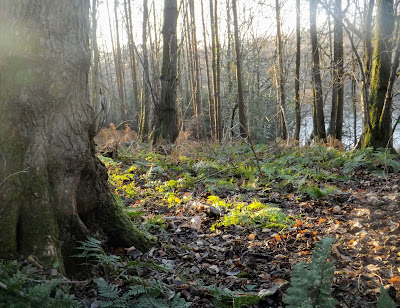A beautiful day. Cold but gloriously sunny. We started the day with more hedge planting along the roadside, a project we began last winter. The idea is to do a bit more each year until there is a substantial barrier between the wood and the road, and then, when it has grown tall and thick enough, start laying it in the traditional way. It's all experimentation so we'll see how it goes. The hedging plants have done better at the northern end , not so well at the south. Not sure why, perhaps because it's shadier down there, and the ground is definitely worse, almost all sandstone and clay.
Hazel before it is coppiced or pollarded
While ideally we would coppice them it's going to be almost impossible because the deer will eat all the emerging new shoots however much we try and protect them. So, we'll pollard the stems, i.e. cut them at above deer munching height . At least this will add a different height layer to the wood. The Willow Grove which we started working on a few years ago, has been very successful in creating a much needed shrub layer for the wood. That project is ongoing , we are still felling birch there, and will have to cut the pollard stems soon, but we are pleased with the results of our work. Luckily, hazel is much easier to cut than hard springy willow, so it shouldn't take us too long to get the job done.
.
Pollarded hazel, surrounded by the cut tops, to keep the deer from eating the new Spring shoots
.
Part of the pollarded Willow Grove in winter.
At this time of the year. the wide paths made by the machinery during the Scots Pine plantation thin in late 2015 are very noticeable. After the work was done, these paths were just churned mud, but now they are grassy small glades , with a much more diverse ground flora. This is because the tractor flattened the bracken and seems to have destroyed its rhizomatic roots - the welcome result being that it hasn't returned! a real bonus. It might even be worth doing a bit more thinning in the Scots Pine area just to get rid of more bracken. Bracken is a problem for us, and there is a great deal of information on this: e,g, as Professor Rob Marrs from Liverpool University says:
It's easier and faster to do this time around because we're not using rabbit spirals as there don't seem to be any rabbits, or bamboo canes as these don't seem to have much of a purpose. The plants appear to be doing fine without them. Plus, we're becoming tree and hedge planting experts!
There is quite a lot of badly neglected hazel at the southern boundary . Originally planted for coppicing, it hasn't been touched for many years , and branches have grown long, thin and tangled , bending in all directions, and over 30 feet in height. Cutting will improve its health and strength.
.
.
Part of the pollarded Willow Grove in winter.
At this time of the year. the wide paths made by the machinery during the Scots Pine plantation thin in late 2015 are very noticeable. After the work was done, these paths were just churned mud, but now they are grassy small glades , with a much more diverse ground flora. This is because the tractor flattened the bracken and seems to have destroyed its rhizomatic roots - the welcome result being that it hasn't returned! a real bonus. It might even be worth doing a bit more thinning in the Scots Pine area just to get rid of more bracken. Bracken is a problem for us, and there is a great deal of information on this: e,g, as Professor Rob Marrs from Liverpool University says:
'Brambles, bracken and ivy are threatening the future of Britain's woodland, new research has concluded. ... Biologists fear the plants are a major threat to biodiversity in Britain's wooded areas and are potentially more damaging than invasive species that have been introduced to the countryside from abroad'.
New glades thanks to tractor bashing.
A stroll through the 'wet wood' , though not as wet as it should be this dry winter, on the way to the (soon to be ) Hazel Grove
Full moon tonight, reflected in the Hammer Pond.












No comments:
Post a Comment